Not Identical, but the Same: Yuuki Matsumura’s ‘Almost-Dead Sculpture’
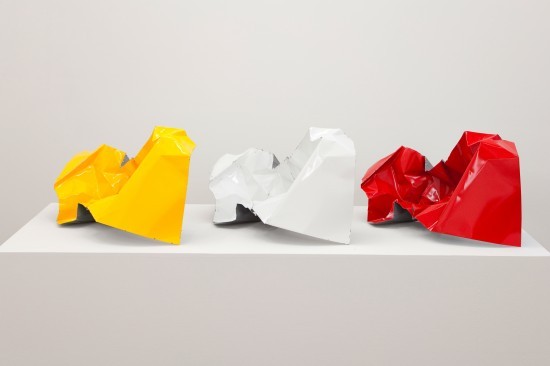
Yuuki Matsumura – Untitled (2009), set of three aluminum sheets, 30 x 65 x 45 cm, each.
Let’s begin with the dualism of “things that can be reproduced any number of times” and “multiple things that can be substituted,” versus “real things of which there are only one” and “singular things that are irreplaceable.” To put it another way, this is the familiar modern dualism of the system and that which lies outside it, or “things that are no more than differentiated positions within the system” and “things that have been described completely by way of images or information,” versus “the real world prior to differentiation” and “externality that is unable to be reduced to a bundle of images or information.”
From as early as the mid-1960s in some parts of the world (the timing varied depending on affluence – in the case of Japan it was from the mid-1970s), post-war society underwent a radical transformation into a post-modern information media society. An information media society is characterized by the intrusion of visual information into every nook and cranny of society due to the explosive development of media (photographic magazines, television), as a result of which information and images mold our world in advance of actual reality. The world becomes photographic, as it were, and consequently the “realness” of things is diluted, giving rise to the sense that everything is being swallowed up in a stream of information. This ultimately produces an existential fear that “the self” as an irreplaceable presence may in fact be nothing more than a “position” within the system that is interchangeable with anyone. From this arises the question of how we should address singularity/individuality in the midst of the wholesale reproducibility/interchangeability of media society.
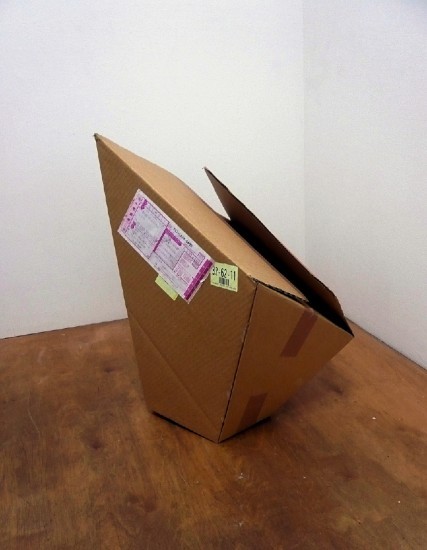
Yuuki Matsumura – Eye-Scratch Cardboard Box 2 (2007), cardboard box, tape, Yamato
Logistics sticker, 61 x 45 x 50 cm.
Let’s consider Yuuki Matsumura’s artworks in light of this question. Matsumura transforms ready-made articles into one-off items and bestows a kind of absolute individuality on commonly available commodities that can be purchased anywhere, enacting in this method a kind of “destruction.” To the extent that the destroyer cannot control the destruction process, destruction enables the artist to create unrepeatable, one-off forms. A delivery-service cardboard box that has been crushed; a length of rectangular lumber bought from a home center that has snapped: from the various forms that arise, the artist chooses not the shapes that one would normally expect to find when things are crushed or snapped, but forms that demonstrate an interesting way of breaking, and turns these into artworks.
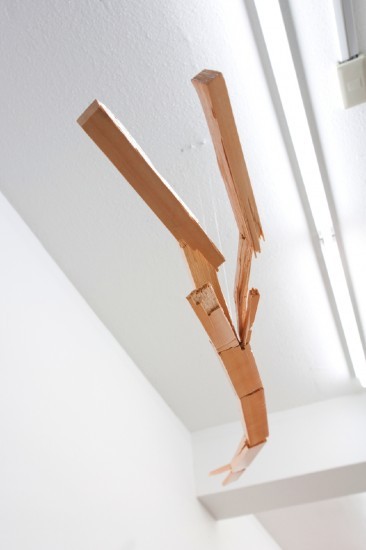
Yuuki Matsumura – Boki (2009), wood and lacquer, 10 x 15 x 130 cm.
Photo Kei Okano.
But what makes Matsumura’s art really unique is that he then attempts to repeat multiple times the one-off forms that arise by chance as a result of the “destruction” process. He twists sheets of aluminum in imitation of the caved-in panel of a smashed car, or crushes a plastic bucket and then duplicates the exact same form in other buckets. If one looks closely, however, one sees that while the repeated forms appear identical, each one is slightly different. This is because Matsumura’s repetition is done completely by hand. Employing an almost perverse skilfulness, he reproduces over time with simple honesty the accidental forms that have arisen as a result of destruction. But what meaning is there to this?
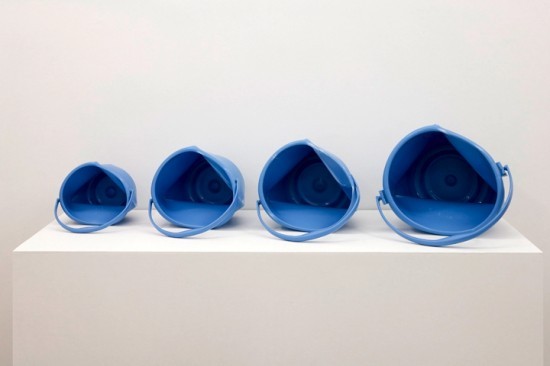
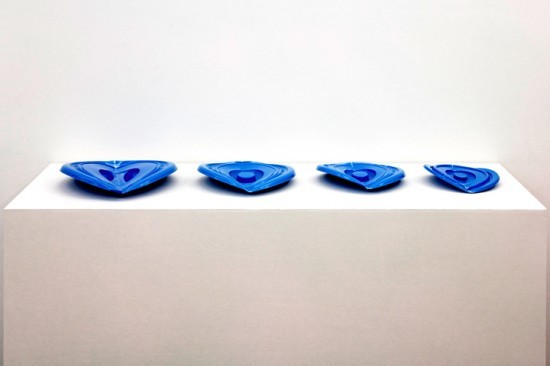
Both: Yuuki Matsumura – Almost-Dead Sculpture (Bucket) (2010), plastic buckets. Photo Kei Okano.
Pop Art, especially the art of Andy Warhol, could be said to have been one answer to the question of how to address singularity/individuality in the midst of the wholesale reproducibility/interchangeability of media society. As is commonly known, in the period from the 1960s to the early 1970s, many artists queried “representation” and introduced into their works not representation but “index” symbols. Rather than representing/substituting for the “thing” that it signifies, an “index” is a physical trace that corresponds one-to-one with the “thing,” or in other words is linked to it directly without an intermediate (media). “Indexes” are symbols guaranteeing a sure connection with “things” and “the real world” in an increasingly mediated society.
Photographs are traces of light etched onto photosensitive material at single, irreplaceable moments (decisive moments) and at the same time a kind of index symbol. But in the sense that they record those direct traces as “molds” (negative film), they are also a form of media enabling those “single moments” to be reproduced any number of times. This is why photography can be considered the ultimate betrayal of “irreplaceable individuality.” Warhol’s photoengraving-based works, especially the series in which photographs of electric chairs, automobile accidents and so on are repeated, use the essence of the betrayal of the medium of photography to cynically draw attention to the cruelty of our information media society, which consumes everything, even down to the existence of each irreplaceable individual (a single death). It is as if to say individual things – irreplaceable things – are now nothing but reproducible, and mass-producible, products.
In this sense, as a tendency it is possible to interpret the photorealism of artists like Chuck Close as the complete opposite of the cynicism of Pop Art, which shows individuality being gradually broken down into reproducibility. By taking a photographic image that can be reproduced any number of times and transforming it into a brilliantly rendered oil painting – that is, a handmade, unique work of art – these artists are cancelling out the betrayal of photography through painting.
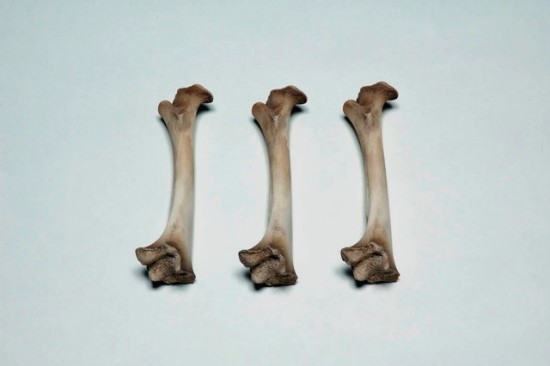
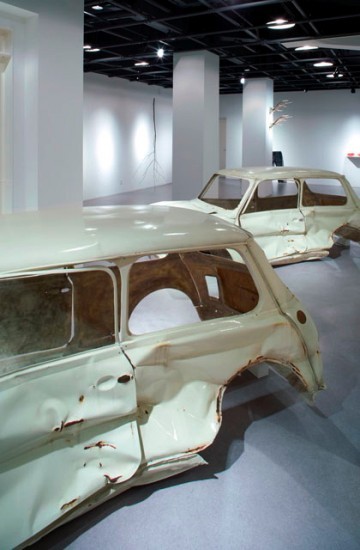
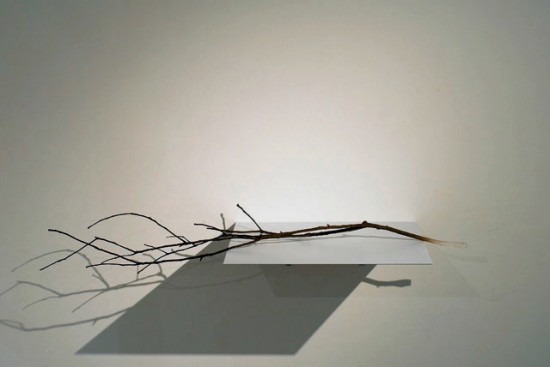
Top: Nobuaki Onishi – hone (2006), acrylic on urethane resin, 14 x 3 x 3 cm each. Middle: mini kupa (2008), FRP, acrylic and lacquer on urethane resin, 115.5 x 303.8 × 137 cm. Installation view at Chukyo University C Square, 2009. Bottom: eda (2007), acrylic on urethane resin. Courtesy the artist.
With their use of Warhol-like motifs such as auto accidents, the artworks of Nobuaki Onishi initially look similar to those of Yuuki Matsumura. Onishi takes molds of things like bones (which one would expect to differ from individual to individual), car bodies mangled in auto accidents and branches that have grown organically, and then reproduces them by realistically describing the surface texture of each one. This expression is a direct descendant of Warhol and his questioning of “individuality” and “reproducibility,” and with its reproduction of reality through painting in such a way that one almost mistakes the artworks for real objects, it is also a scion of photorealism. (1) However, by pursuing simultaneously individuality and reproducibility (the two methods of Warhol and Close, respectively), Onishi offsets one against the other. His zero-sum methodology is plainly apparent.
In contrast to this, what is peculiar about Matsumura’s work is that it is dissimilar to both that of Warhol and of Close. The relationship between individuality and repeatability is different for Matsumura than it is for Warhol/Close/Onishi. This is because he doesn’t use “molds.” To put it another way, the objects that are lined up together and look the same don’t have the kind of index-like relationship found in photography and molding. In the work with buckets, the size changes with each repetition, emphasizing the fact that this repetition is not “duplication” by means of a mold. (2) The method is the same with Matsumura’s new body of work, “Almost-Dead Sculpture (Nude).” First, a substitutable thing is given once-only individuality by way of “destruction.” If one were to cut out a page from an adult magazine with a nude photograph – a substitutable, non-original nude photograph – and crumple it into a ball, after a while the tension in the folds of the paper would relax into an equilibrium that determines the final shape of the crumpled paper. This state indicates a completely random, once-only shape. Next, this once-only shape is not duplicated, but repeated, completely by hand. Matsumura adheres oversized reproductions of nude photographs taken from adult magazines onto rectangular steel sheets, and then bends the sheets to resemble oversized pages from adult magazines that have been individually crumpled up and allowed to slightly unfold like pieces of wastepaper. It is likely that the title “Almost-Dead Sculpture” refers to the fact that the models’ bodies and limbs have been bent into impossible shapes.
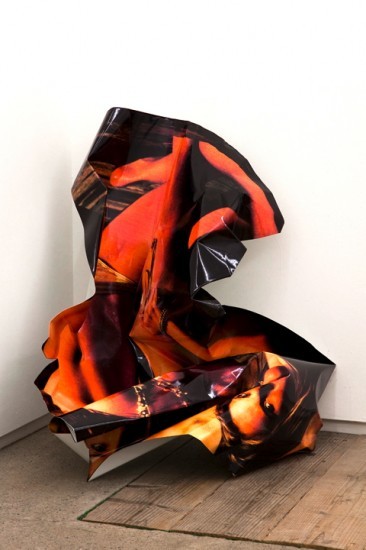
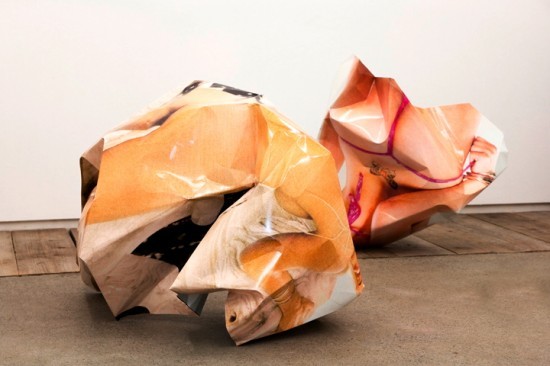
Both: Yuuki Matsumura – Almost-Dead Sculpture (Nude) (2010), steel sheet. Photo Kei Okano.
A repetition of something that isn’t a replica, or in other words something that is “the same” but that lacks the “mold” upon which this sameness would be based, “the same” but not “identical.” It seems Matsumura’s aim is to open up “singularity” to this kind of baseless “sameness.” The singularity in the work of Warhol/Close/Onishi and its identical reproduction sharply contradict each other, but in Matsumura’s work singularity is open to the repetition of “the same” thing.
What, then, is “sameness”? I don’t think there’s any need to hasten to a conclusion with an artist who has only just finished his second solo exhibition. The four buckets, for example, “look the same,” yet there is no basis for this in the form of “molding.” In other words, the only thing supporting their sameness is not the identity of each individual object itself, but the viewer who perceives and recognizes their individuality. Since the early “Eye-Scratch” series, it has been clear that Matsumura’s interest lies in “ways of seeing” things, the physical world, and so on.
Yuuki Matsumura’s “Almost-Dead Sculpture” was on display at Take Ninagawa, Tokyo, from June 26 to July 31.
Unless otherwise noted all images courtesy Take Ninagawa, Tokyo.
-
Many critics are debating Onishi’s works in terms of the problematique of “real” versus “fake,” but this trivializes his work by consigning it to the realm of things like stage design (realistic rocks made from resin, etc) and food samples.
- Of course, “molds” can be mechanically enlarged or reduced, but the sizes of all the exhibited works are different. If one were to make an individual mold for each object, then the “molds” would lose their meaning.
Archive
Critical Fieldwork: Observations on Contemporary Art in Japan 1-6
